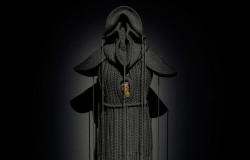A family robbed by the Nazis donated two 17th century paintings to the Louvre Museum in Paris.
AFP
Two 17th century still lifes, looted during the Occupation and exhibited at the Louvre Museum in Paris since the 1950s due to failure to find their owners, were returned to the 48 beneficiaries of a Jewish family who donated them to the largest museum in the world.
A large number of rights holders, as well as their children and grandchildren, gathered on Tuesday around the two paintings, “Still life with ham” by Floris van Schooten and “Food, fruit and glass on a table” by Peter Binoit , probably painted in 1630 and 1620.
These works will be exhibited to the public at the Louvre from Wednesday, alongside historical documents on the family who owned them.
It is a “duty of memory towards my family, despoiled and persecuted, whose history speaks to current generations,” one of the rights holders, Marion (who wished to remain anonymous) told AFP.
She explains that she was the “point of contact for all the steps which ultimately made it possible to achieve this outcome after a long period of work and thanks to a lot of energy”.
For her, this exhibition “testifies to a rich and interesting group of people who were made full French citizens during the Revolution and had very different destinies, some having been deported and having fought until the end, others having resisted, having hidden and having escaped the cracks,” she explains.
For the president and director of the Louvre, Laurence Des Cars, it is a “call to never forget, a commitment to transmitting memory and a constant reminder to action,” she commented in a communicated.
Genealogy
The two paintings, whose provenance was unknown, were for a long time present in the Nordic painting rooms of the Louvre under the status of “National Recovery Museums” (MNR) works, looted works not returned after the Second World War and entrusted to the custody of national museums.
The beneficiaries of the Javal family, five members of which were deported and murdered at Auschwitz, were recently found thanks to the efforts of researchers from the French Ministry of Culture, the National Archives and the Commission for Compensation for Victims of spoliations (CIVS), helped by genealogists.
“Proactive research made it possible to understand that the two paintings, considered by the Nazi looting organization Einsatzstab Reichsleiter Rosenberg (ERR) as belonging to the C Juralides D collection, actually belonged to Mathilde Javal, whose private mansion at 5 , boulevard de la Tour-Maubourg, 7th arrondissement (of Paris, Editor’s note), had been occupied and emptied in 1944,” the ministry said in a press release.
Letter
Mathilde Javal, daughter of Emile and Marie-Anna Javal and sister of Alice and Jeanne, had officially requested the restitution of her family’s works of art at the end of the war, in 1945, as evidenced by a letter which allowed us to “go back the thread” of history, according to the Louvre, and which is presented in the exhibition.
The paintings, stolen in 1944 from the family mansion, could not be returned upon their return from Germany, due to lack of knowledge of their rightful owners. Two errors in the spelling of the name Javal and the address of Mathilde, the last occupant of the building, also caused confusion, according to the Louvre Museum.
Through a 2015 agreement with the Ministry of Culture, Généalogistes de France, the national representative organization of genealogy professionals, agreed to carry out free of charge the research necessary to identify the living rights holders of six owners of works “ MNR”, including the Javal.
Between 1940 and 1945, around 100,000 cultural items were looted in France, mainly from Jewish families, by the Nazi regime and the Vichy Government, or sold under duress. Many of them were transferred to Germany.
At the end of the war, around 60,000 works were returned to France, of which 45,000 were returned to their owners by the Artistic Recovery Commission, whose activity ceased in 1949. Of the remaining 15,000, around 13,000 were sold by the State and 2,200 entrusted to the custody of national museums. They constitute the so-called “MNR” works and do not belong to the national collections.
The Louvre is therefore responsible for 1,610 “MNR” works, including 791 paintings.
(afp)






